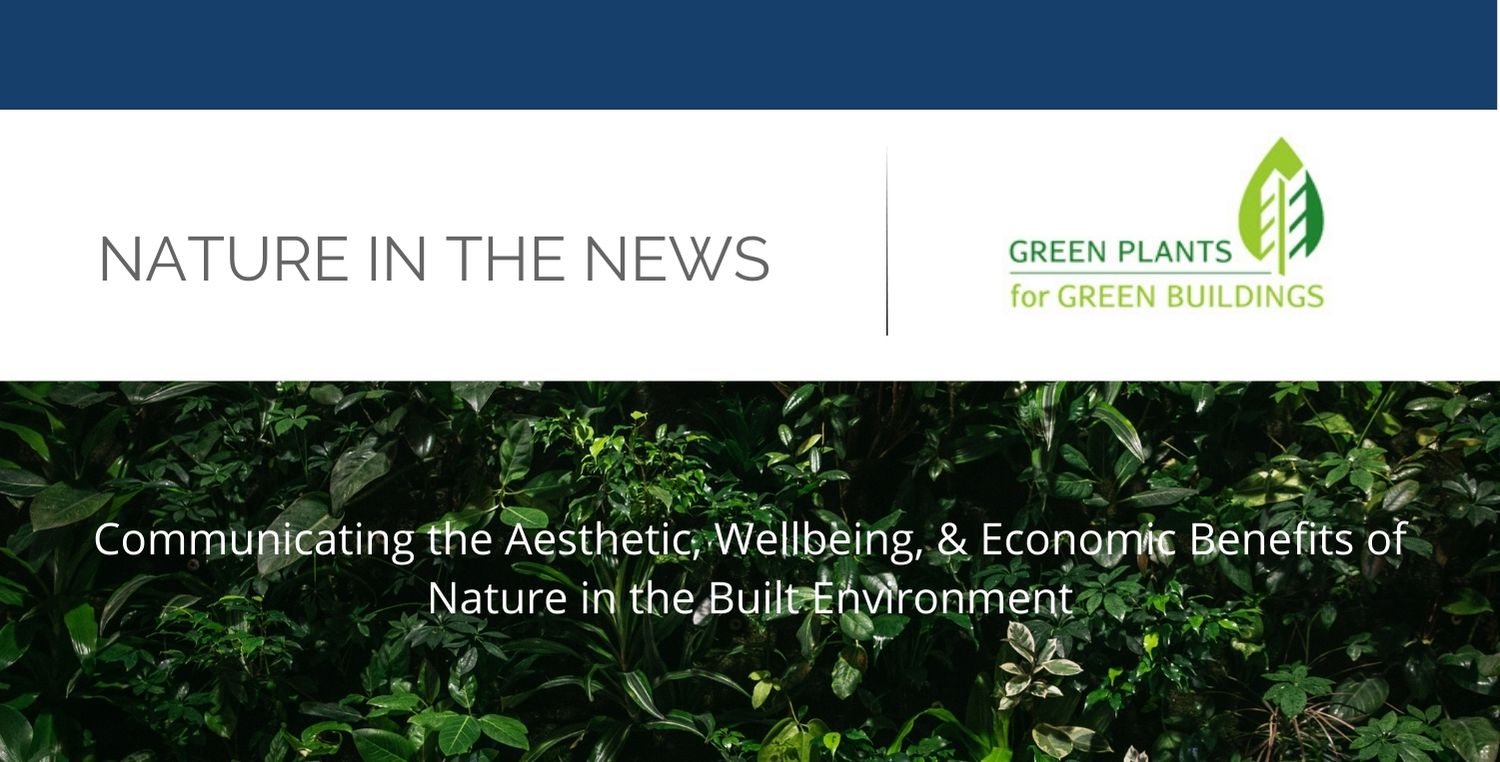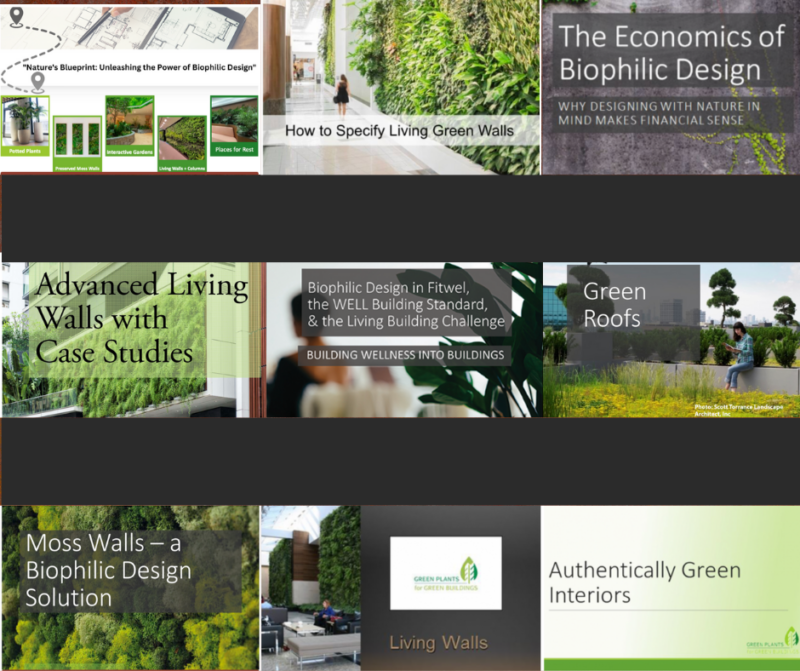
This e-newsletter brings you the latest information and resources on biophilic design, the industry, and GPGB updates.
Five Benefits of Leaning into Brand Identity and Culture for Office Design

Credits: Gensler, September 12, 2024 | By Katie Kaiser and Jacqueline Zuhoski
Picture Credit: Gensler, Synopsys, Sunnyvale, California
The office design for Synopsys, a tech company committed to sustainability, wellness, and innovation, emphasizes biophilic design elements to enhance employee well-being and engagement. Key biophilic features include plant walls developed by Biome, which use smart technology to improve air quality and self-maintenance, aligning with Synopsys’ sustainable and future-forward ethos. Visual connections to nature and the integration of natural elements throughout the office foster health, creativity, and productivity. The design promotes wellness through dedicated wellness rooms and a fitness center, encouraging active lifestyles and creating a human-centered, health-conscious workspace that reflects Synopsys’ brand values and culture.
Adopting AIA Resolution #1: Prioritizing Human Wellness in Architectural Design

Credits: Living Architecture Monitor
By Dr. Tuwanda Green, AIA
Photo Credits: Paimio Sanatorium’s patient terrace overlooking the pine forest. Photo: © 2024 Dr. Tuwanda Green, AIA
…Monumental actions occurred at the American Institute of Architects (AIA) June 2024 conference. Adoption of resolution #1 during the annual townhall meeting marked the first tangible steps towards prioritizing humans in design. Specifically, “The intent of this resolution is to increase AIA members’ value to their clients by embracing evolving knowledge and trends in health and well-being, by clarifying specific policies, and by promoting research-based relationships of architecture’s impact on human health and well-being. This is an ethical issue and requires related adjustments to AIA’s Code of Ethics and Professional Conduct plus the Framework for Design Excellence.” [1]
They propose that “due to the lack of specific reference to human health and wellness as a primary goal, the aim is to add appropriate elements to the current 2020 Code of Ethics and Professional Conduct that require a focus on human wellbeing as well as promoting related discussions with owners and utilizing health and wellbeing-related research pertinent to proposed design interventions.” [1]…
…Adoption of AIA’s Resolution #1 will most notably help educate the architect on their crucial role in human health and thriving. It is my sincere hope that this resolution is already spurring conversations with the National Architectural Accrediting Board (NAAB) and Association of Collegiate Schools of Architecture (ACSA), a nonprofit organization for the advancement of architectural education and research. Additional meetings and discussions must occur to officially decree this resolution, so keep your eyes open! The state of our human and ecological health globally indicates that we’re almost 100 years behind schedule… Let’s DO this!
AEC Industry Survey

AEC Industry Experts,
We want to hear from you! As we continue to shape the future of Green Plants for Green Buildings (GPGB), we want you to know that your voice is crucial in our strategic planning process. Your insights will guide the direction and priorities of our organization, ensuring we stay focused on what truly matters.
We kindly ask you to take a few moments to complete a brief GPGB Survey directed to AEC Industry Experts. Your input will directly influence the decisions that shape GPGB’s future initiatives.
Please share the survey link with all your industry contacts!
Supporter Video Calls

Cultivating Horticultural Hospitality
Hosts, Jan Goodman and Mike Senneff, discussed the latest takeaways of excellent and unbelievable hospitality from industry conferences such as Cultivate, SHRM, and the Global Leadership Summit in the latest supporter video call.
GPGB welcomes all to join and participate in the industry calls!
Call to Action: Support and/or “Level-Up” with GPGB

Our purpose is to communicate the aesthetic, wellbeing, and economic benefits of nature in the built environment. The target audience is the commercial specifier, building owner, facility manager and related decision makers.
Thanks to our supporters, we have been extremely successful in reaching our audience. There is unparalleled awareness of the economic benefits of interior plants and more plants are being specified in building projects than ever. The industry has never been stronger! We want to capitalize on our momentum and assure plants become a permanent element in commercial design.
GPGB is asking for increased support. GPGB has just completed an overhaul of our supporter tiers and added new benefits at each level. As important as the benefits are, the primary reason to support is to help us influence more decision makers on the benefits of plants, and ultimately grow the industry, and grow your business.
Support Expired or haven’t increased support?
➡️ Click here to renew and/or “level-up” TODAY!
Continued Education Units

📢 Year-End CE Credit Rush: Perfect Time to Pitch GPGB Courses!
As the end of the year approaches, A+D professionals are racing to meet their continuing education (CE) credit quotas. For GPGB Registered Trainers, this is the ideal moment to connect with architecture and design firms, offering them valuable insights on green design topics like living walls, moss walls, green roofs, biophilic design, and more. 🌿
Why Biophilic Design Matters Now
The benefits of incorporating natural elements—like live plants—into buildings are increasingly well-documented. Biophilic design has measurable impacts, including:
- 🌱 Reduced absenteeism
- 🏢 Increased tenant occupancy and retention
- 💼 Boosted productivity and satisfaction
- 🌬️ Improved indoor air quality
- 🛍️ Increased retail spending
- 🚶 Directing pedestrian traffic
- 🎨 Creating bold design statements
With the rise of building standards such as the WELL Building Standard, Fitwel, LEED, and the Living Building Challenge, biophilic design has become essential to modern architecture. This shift has driven a growing need for professionals to understand how to effectively incorporate natural elements into the built environment.
GPGB: Your Source for CE-Credited Courses
As part of GPGB’s mission to highlight the aesthetic, wellbeing, and economic benefits of nature, we’ve developed continuing education courses certified by leading professional organizations. These courses feature research-backed insights into the impact of biophilic design on health, safety, and welfare.
With these valuable resources, you can help firms stay ahead of industry trends while fulfilling their CE requirements. Don’t miss this opportunity to position yourself as a trusted expert on biophilic design! 🌿
Get in Front of A+D Professionals Today!
Now is the time for Registered Trainers to pitch GPGB courses to firms eager to complete their CE credits. Offer knowledge that goes beyond theory—demonstrate how incorporating nature into buildings can transform spaces and improve outcomes for everyone who interacts with them.
Make your mark on the built environment with GPGB’s top-tier educational tools!
Volunteers Wanted for Committees and Board of Directors
GPGB depends on the work of volunteers to carry out our strategic initiatives and fulfill our mission. Serving on a committee or as a GPGB board member is a rewarding experience and an opportunity for personal and professional growth. If you can make a minimum two-year commitment, the industry needs people like YOU!
We are actively looking for committee members and board members who are passionate about biophilia.
Volunteering with GPGB is about becoming part of a movement that integrates nature into our everyday spaces for better health, productivity, and sustainability. With exclusive tools, education, and networking opportunities, GPGB helps you stay ahead in the evolving A+D landscape and opens doors for both professional and personal growth.
🌱 Elevate your career and your impact—volunteer with GPGB today!
- Marketing & Communications
- Supporter Development
- Education & Professional Development
Thank You to Our Supporters!
GPGB is making a difference and it’s all thanks to our valued supporters. Our supporter’s participation and contribution is greatly appreciated not only by us, but by everyone in the industry.
Thank you for continuing to add your voice to the hundreds of other industry professionals committed to integrating plants into our built environments. We appreciate your understanding and willingness to “Level-Up” this year!
Continued Supporter Call To Action: Please continue to add your reels, shorts, stories, and all other 15-30 second videos related to biophilia here in order to be featured on GPGB social media.
Biophilic Gallery

Credit: PR Newswire, Merrell
Location: Studio 525 Chelsea New York
Merrell expanded on its mission of sharing the simple power of being outside with everyone by making nature more accessible for New Yorkers, bringing the trail to the heart of the city. The Wander Wheel is a large, interactive sculpture slowly spinning on a static base, transporting visitors to diverse natural environments from around the world in each of the four hemispheres.
From the flowering hills of California to the snowy passes of Switzerland, and the dramatic landscapes of Brazil to the vast plains of the Australian Outback, attendees could explore these breathtaking trails within the confines of the wheel as they walk on the moving installation.

Credits: PARKROYAL on Pickering / WOHA© Patrick Bingham Hall, Arch Daily
Singapore-based WOHA Architects have long been advocates of the ultimate ‘green city’ – one that would be comprised of more vegetation than if it were left as wilderness – and the PARKROYAL on Pickering was designed as a hotel-as-garden that actually doubled the green-growing potential of its site.
Massive curvaceous sky-gardens, draped with tropical plants and supporting swathes of frangipani and palm trees, are cantilevered at every fourth level between the blocks of guest rooms. Greenery flourishes throughout the entire complex, and the trees and gardens of the hotel appears to merge with those of the adjoining park as one continuous sweep of urban parkland.
Want to Help Keep Nature in the News?
 Everything we accomplish happens because people like you are stepping forward and supporting GPGB’s focus on having conversations with the building professionals who can #BringNatureIndoors.
Everything we accomplish happens because people like you are stepping forward and supporting GPGB’s focus on having conversations with the building professionals who can #BringNatureIndoors.
If the spirit moves you, please consider supporting our work by making a donation.
